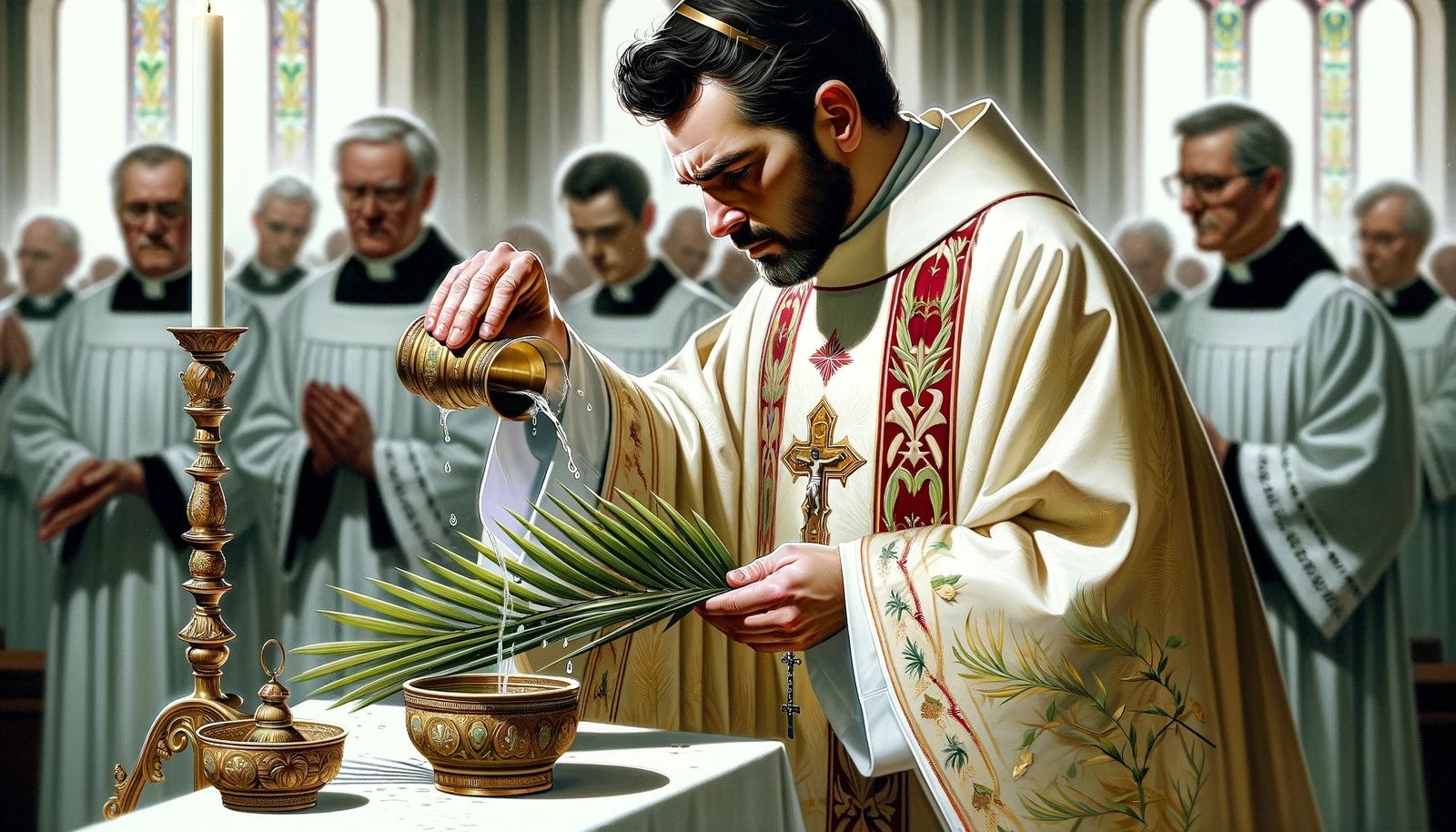Home>Special Themes>What Color Represents Lent?


Special Themes
What Color Represents Lent?
Published: February 27, 2024
Jason DeRose, Managing Editor at Christian.net, uses his expertise in religion and journalism to deepen understanding of faith's societal impacts. His editorial leadership, coupled with a strong academic background, enriches the platform’s diverse content, earning him recognition in both journalism and religious circles.
Discover the significance of the color purple in representing Lent and other special themes. Explore the symbolism and traditions associated with this solemn period.
(Many of the links in this article redirect to a specific reviewed product. Your purchase of these products through affiliate links helps to generate commission for Christian.net, at no extra cost. Learn more)
Table of Contents
The Symbolism of Purple in Lent
Purple holds significant symbolism in the observance of Lent within the Christian faith. This color is associated with penance, preparation, and the anticipation of the resurrection of Jesus Christ. The use of purple during Lent serves as a visual representation of the solemn and reflective nature of this season in the liturgical calendar. It is a color that encourages introspection, repentance, and spiritual growth as believers prepare for the celebration of Easter.
-
Penitence and Purity: The color purple is often linked to penitence and the acknowledgment of one's sins. It serves as a reminder of the need for repentance and the purification of the soul. During Lent, individuals are encouraged to engage in acts of self-discipline, prayer, and reflection, and the color purple reinforces the solemnity of this spiritual journey.
-
Royal and Regal Symbolism: Purple has historically been associated with royalty and nobility. In the context of Lent, this symbolism is interpreted as a reflection of the sovereignty of Jesus Christ and his sacrificial journey towards the crucifixion. The use of purple underscores the regal nature of Christ as the King of Kings, even as he humbly endured suffering for the redemption of humanity.
-
Preparation and Anticipation: As a color that signifies preparation and anticipation, purple embodies the period of waiting and expectation during Lent. It serves as a visual cue for believers to prepare their hearts and minds for the joyous celebration of Easter, which marks the resurrection of Christ. The use of purple underscores the significance of this preparatory phase in the Christian faith.
-
Mourning and Reflection: In some traditions, purple is also associated with mourning and reflection. During Lent, believers are called to reflect on the suffering and sacrifice of Jesus, as well as their own mortality and the need for spiritual renewal. The somber tone of purple aligns with this introspective aspect of Lenten observance.
The symbolism of purple in Lent extends beyond its visual appeal, serving as a powerful reminder of the spiritual themes and theological significance of this sacred season. As believers engage in prayer, fasting, and acts of charity, the presence of purple reinforces the depth of meaning inherent in the Lenten journey.
Read more: What Do Ashes Represent During Lent
The Historical Significance of Purple in Lenten Traditions
The historical significance of purple in Lenten traditions can be traced back to the early centuries of Christianity. During this time, the use of purple was closely associated with royalty, wealth, and luxury. The dye used to create purple fabric was derived from the mucus of a specific sea snail, making it an expensive and highly prized commodity. As a result, purple became synonymous with power, prestige, and exclusivity.
In the context of Lent, the adoption of purple as a symbolic color can be linked to the early Christian communities' deliberate choice to repurpose the meaning of this regal hue. By incorporating purple into the observance of Lent, the Church sought to imbue this season with a sense of solemnity, humility, and spiritual significance. The intentional use of a color historically associated with opulence and grandeur served as a powerful statement about the transformative nature of the Lenten journey.
Furthermore, the historical significance of purple in Lenten traditions is also rooted in the liturgical practices of the Church. As early as the 4th century, there is evidence of purple fabrics and vestments being utilized during the Lenten season. These visual elements served as a means of communicating the distinctiveness of Lent within the broader liturgical calendar. The deliberate choice to adorn churches, altars, and clergy with purple reinforced the unique character of this period of fasting, prayer, and repentance.
Additionally, the historical significance of purple in Lenten traditions is intertwined with the theological themes of redemption and sacrifice. The color purple, with its association with royalty and nobility, became a poignant symbol of Christ's sacrificial journey to the cross. By using purple to adorn sacred spaces and ceremonial garments, the Church emphasized the paradox of Christ's divine kingship and his willingness to endure suffering for the salvation of humanity.
In summary, the historical significance of purple in Lenten traditions reflects a deliberate and purposeful appropriation of a color with rich cultural and symbolic meanings. Through its use, the early Christian communities sought to infuse the observance of Lent with a sense of reverence, humility, and anticipation, while also underscoring the profound theological truths at the heart of this sacred season.
Other Colors Associated with Lent
In addition to purple, several other colors hold symbolic significance in the context of Lent. Each color carries its own unique meaning and contributes to the rich tapestry of visual symbolism associated with this sacred season. Understanding the diverse palette of colors associated with Lent provides a deeper insight into the multifaceted themes and spiritual dimensions of this period of preparation and reflection.
-
Ashen Gray: The color gray, particularly in the form of ashes, is closely linked to the observance of Ash Wednesday, which marks the beginning of Lent. The imposition of ashes on the foreheads of believers serves as a stark reminder of human mortality and the need for repentance. The ashen gray color represents humility, penitence, and the transient nature of earthly life.
-
Scarlet Red: While red is often associated with passion and love, its use in Lent is symbolic of Christ's sacrifice and the shedding of his blood on the cross. The color red serves as a poignant reminder of the suffering and martyrdom endured by Jesus, underscoring the profound depth of his love for humanity.
-
Sackcloth Brown: Brown, reminiscent of coarse sackcloth, is a color associated with humility, simplicity, and self-denial. It symbolizes the renunciation of worldly comforts and the embrace of a more austere way of life during the Lenten season.
-
Verdant Green: Green, often associated with growth, renewal, and vitality, holds significance in the latter part of Lent as a symbol of hope and the promise of new life. As believers journey through the season of repentance and introspection, the emergence of green serves as a visual representation of the anticipation of spiritual rejuvenation and the arrival of Easter.
-
Sorrowful Black: Black, while not as commonly used in Lenten decorations, can symbolize the solemnity and mourning associated with Christ's crucifixion. It serves as a reminder of the darkness and sorrow that preceded the joyous resurrection, emphasizing the gravity of the sacrifice made on Good Friday.
The incorporation of these diverse colors into the observance of Lent enriches the visual and sensory experiences of believers, deepening their engagement with the spiritual themes and narratives of this sacred season. Each color contributes to the multifaceted journey of Lent, guiding individuals through moments of introspection, repentance, and ultimately, the celebration of Christ's triumph over death.
The Importance of Color in Lenten Observance
The use of color in Lenten observance holds profound significance, as it serves as a visual and symbolic language that communicates the spiritual themes and narratives of this sacred season. The deliberate selection and incorporation of specific colors into the liturgical and devotional practices of Lent contribute to a multi-sensory experience that engages believers on a profound emotional and spiritual level.
-
Visual Representation of Spiritual Themes: Colors serve as visual representations of the spiritual themes and theological truths central to the Lenten journey. Each color carries its own symbolic meaning, effectively conveying aspects of penitence, sacrifice, anticipation, and renewal. The visual impact of these colors enhances the immersive nature of Lenten observance, inviting believers to reflect deeply on the significance of the season.
-
Enhancement of Worship Spaces: The use of color in Lenten decorations, vestments, and sacred art enhances the aesthetic and sensory appeal of worship spaces. The deliberate incorporation of purple, gray, red, and other symbolic colors creates an atmosphere that is conducive to contemplation, prayer, and spiritual introspection. The visual elements of color contribute to the creation of a sacred environment that supports the spiritual journey of believers.
-
Cultural and Historical Continuity: The use of specific colors in Lenten observance also reflects a sense of cultural and historical continuity within the Christian tradition. Through the intentional selection of colors with deep historical and symbolic significance, the Church maintains a connection to its rich heritage and the enduring practices that have shaped the observance of Lent over centuries.
-
Emotional and Psychological Impact: Colors have the power to evoke emotional and psychological responses, influencing the mood and mindset of individuals. In the context of Lent, the use of somber hues such as purple and gray fosters a sense of introspection, humility, and repentance. Conversely, the emergence of vibrant colors like green and red in the latter part of Lent can evoke feelings of hope, renewal, and anticipation.
-
Educational and Symbolic Significance: The use of color in Lenten observance also serves an educational purpose, particularly for younger members of the faith community. Through exposure to the symbolic meanings of different colors, individuals, including children, are provided with a tangible and accessible means of understanding the spiritual narratives and lessons embedded within the Lenten season.
In summary, the importance of color in Lenten observance extends beyond mere aesthetic considerations. Colors play a pivotal role in conveying the depth of spiritual meaning, enriching the sensory experiences of believers, and fostering a profound engagement with the themes of repentance, sacrifice, and ultimately, the hope of resurrection. The deliberate use of color in Lenten observance underscores the multi-dimensional nature of this sacred season and its enduring impact on the hearts and minds of the faithful.















